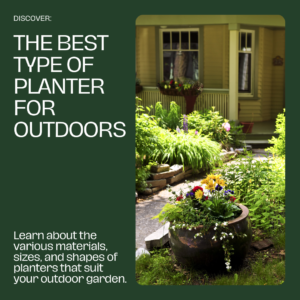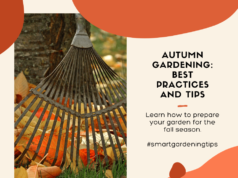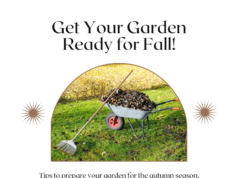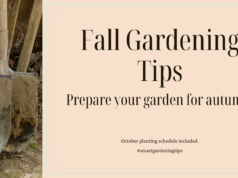
Are you looking to enhance your green space and create a beautiful outdoor oasis? Choosing the right type of planter is essential. With so many options available, it can be challenging to determine which planter is best suited for your outdoor space. In this article, we will explore the advantages of different types of outdoor planters and help you select the best type that will not only complement your outdoor space but also provide the necessary requirements for your plants to thrive.
Key Takeaways
- Carefully consider factors such as size, plant type, and climate when choosing the best outdoor planter.
- Ceramic planters are durable and aesthetically pleasing.
- Plastic planters are lightweight, low-maintenance, and affordable.
- Wooden planters add a rustic charm, but require proper maintenance.
- Concrete planters are durable and offer customization options.
Overview of outdoor planters and their importance
When it comes to creating a beautiful outdoor space, outdoor planters are an essential component. Not only do they add aesthetic value, but they also provide a stable and suitable environment for your plants to grow. Proper drainage and ventilation are crucial for ensuring healthy plant growth, and outdoor planters help to achieve this.
In addition to their functional benefits, outdoor planters allow you to arrange and rearrange your plants to your liking. This flexibility is especially useful for those who enjoy experimenting with different garden designs and layouts.
So, why are outdoor planters important? They play a crucial role in enhancing the beauty and functionality of your outdoor space while providing a stable home for your plants.
Factors to consider when choosing the best type of planter for outdoors
Choosing the right planter is crucial to enhance your green space while also ensuring that your plants thrive. To do this, you need to consider several factors:
- Size of the planter: Consider the size of the planter in proportion to the overall size of your outdoor space. You don’t want it to be too small and cramped or too large that it dominates the area.
- Type of plants: Different plants have varied requirements such as soil, water, sunlight, and space. Consider the type of plants you want to grow and select a planter that meets their specific needs.
- Gardening style: Your overall gardening style is another factor to consider. Do you prefer a traditional or contemporary look? Do you like a lot of color or a simpler design?
- Climate: The weather conditions can also impact your choice of planter. If you live in an area with harsh winters, you may want to choose a planter made of a more durable material that can withstand low temperatures.
By taking into account these factors, you can choose the best type of planter for your outdoor space that will not only look great but also ensure that your plants thrive.
Ceramic planters: Advantages of ceramic planters for outdoor use
If you’re looking for a planter that’s both attractive and durable, ceramic planters are an excellent choice for your outdoor space. Their stylish designs are available in various shapes and sizes that complement different gardening styles. Besides, ceramic planters provide excellent insulation for plants, protecting their roots from extreme temperatures, a crucial factor in maintaining healthy plants. One of the biggest advantages of ceramic planters is their resistance to fading, ensuring they maintain their vibrant colors even when exposed to sunlight.
With ceramic planters, you don’t have to compromise on style for strength and durability. They are perfect for adding a touch of elegance to your outdoor setting while still providing reliable protection for your plants. You can explore different designs and colors, choosing one that complements your garden’s aesthetic.
“Ceramic planters are not just decorative, but they are also functional. They enhance the beauty of any garden, and their durability is ideal for outdoor use.”
Plastic planters: Benefits of using plastic planters outdoors
When it comes to choosing a planter for your outdoor space, plastic planters are a practical and affordable option with several benefits. Firstly, plastic planters are lightweight, which makes them easy to move around and rearrange according to your preferences. You can easily shift your plants and plastic planters to a new location without any hassle.
Secondly, plastic planters are less prone to breakage, which makes them ideal for households with pets and children. You won’t have to worry about your kids accidentally knocking them over or your dog chewing on them. They are durable and can withstand wear and tear, making them suitable for high-traffic areas.
Finally, plastic planters are often more affordable than other materials like wood, concrete, or ceramic, which makes them a cost-effective option for those who are on a budget. You can still enjoy a beautiful garden or patio with plastic planters that are both practical and visually appealing.
Wooden Planters: Enhancing Your Outdoor Space with Natural Charm
Wooden planters are a popular choice for outdoor settings, adding a rustic and natural touch to your garden or patio area. If you’re looking for a planter that offers excellent insulation for plants and helps regulate soil moisture, then wooden planters may be the perfect fit for you.
Redwood, cedar, and teak are popular wood choices for outdoor planters due to their natural resistance to decay and insects. However, it’s crucial to maintain your wooden planters adequately to prevent rotting and ensure their longevity.
The Advantages of Wooden Planters for Outdoor Use
- Wooden planters offer natural charm and aesthetic appeal, enhancing your outdoor setting.
- They provide excellent insulation for plants, regulating soil moisture.
- Redwood, cedar, and teak wood are resistant to decay and insects, ensuring longevity.
- Wooden planters are versatile in terms of size and shape, allowing for customization to your outdoor space.
Proper Maintenance for Wooden Planters
| Maintenance Tips | Benefits |
|---|---|
| Regularly clean and scrub the surface of your wooden planters with mild soap and water. | Prevents buildup of dirt and grime that can lead to rotting and damage. |
| Apply a water-resistant sealant to your wooden planters to prevent moisture accumulation. | Protects the wood from water damage, prolonging its life and durability. |
| Avoid painting or staining the interior of your wooden planters. | Allows for proper drainage and prevents harmful chemicals from seeping into the soil. |
“Wooden planters are an excellent choice for enhancing your outdoor space with natural charm. With proper maintenance and care, they can provide long-lasting beauty and functionality to your garden or patio area.”
Concrete planters: Advantages of using concrete planters in outdoor environments
If you are looking for a durable and sturdy option for your outdoor planters, concrete planters are an excellent choice. They offer numerous advantages for outdoor environments, making them a popular option for gardeners and landscapers alike.
One of the biggest advantages of concrete planters is their durability. Made from a tough and sturdy material, they can withstand harsh weather conditions such as extreme heat, cold, and rain. Unlike other materials that can get damaged or tip over, concrete planters remain intact and stable even in adverse weather conditions.
Moreover, concrete planters offer customization options, allowing you to choose from various shapes, sizes, and finishes to suit your outdoor aesthetic. Whether you’re looking for a sleek and modern design or a classic and rustic look, you can find a concrete planter that fits your style and preferences.
| Advantages | Considerations |
|---|---|
| Long lifespan | Heavy and difficult to move |
| Durable and sturdy | More costly than some materials |
| Customizable design options |
Another benefit of concrete planters is their eco-friendliness. Unlike plastic planters that can harm the environment, concrete planters are made from natural materials and can be recycled or repurposed when they reach their lifespan, making them a sustainable option for outdoor gardening.
In summary, concrete planters offer numerous advantages for outdoor environments, including durability, customizability, and eco-friendliness. They are a great investment and a sustainable option for creating a beautiful and functional garden or patio area.
Comparing the Pros and Cons of Ceramic, Plastic, Wooden, and Concrete Planters
Each type of planter, ceramic, plastic, wooden, and concrete, has its own advantages and considerations based on your specific needs and preferences.
| Planter | Pros | Cons |
|---|---|---|
| Ceramic planters | Durable and aesthetically appealing | Can be fragile and more expensive compared to other materials. |
| Plastic planters | Lightweight, affordable, and low-maintenance | May not offer the same level of insulation as other materials. |
| Wooden planters | Provides natural charm and insulates the plants | Require proper maintenance to prevent rotting |
| Concrete planters | Durable and customizable | Can be heavy and more costly |
Choose a planter that aligns with your outdoor space, budget, and plant requirements. Ceramic and concrete planters are sturdier but require more investment, while plastic and wooden planters are lighter and more affordable. To make your choice, consider the level of maintenance, insulation, and aesthetic appeal you desire.
Factors to consider when selecting the best type of planter for specific outdoor needs
Choosing the best type of planter for your outdoor space requires careful evaluation of several factors. By considering these factors, you can ensure that you select a planter that meets your specific outdoor needs. Some of the factors to keep in mind include:
- Budget: It’s essential to determine how much you’re willing to spend on a planter. Different materials come with varying price points, so ensure you choose one that fits your budget.
- Aesthetic preferences: Your choice of planter should complement your outdoor décor and add to the overall aesthetic appeal of your space. Consider materials, designs, and colors that match your style.
- Climate: The climate in your region can affect the viability of certain planter materials. Choose materials that can withstand weather changes and extreme temperatures for durability.
- Specific plant requirements: The type of plants you wish to grow should influence your planter selection. For example, plants that require better drainage benefit from materials such as ceramic and plastic.
Keep in mind that evaluating these factors will guide you in selecting the best type of planter for your outdoor space. Ensure you choose a planter that meets your needs and enhances the beauty and functionality of your green space.
FAQ
Q. What is the importance of outdoor planters?
A. Outdoor planters provide a stable and suitable environment for plants to grow, enhance the aesthetics of outdoor spaces, and allow for flexible arrangements of plants.
Q. What factors should be considered when choosing the best type of planter for outdoors?
A. Factors to consider include the size of the planter, the type of plants to be grown, gardening style, and the climate of the region.
Q. What are the advantages of ceramic planters for outdoor use?
A. Ceramic planters are durable, offer insulation for plants, and come in various shapes, sizes, and designs.
Q. What are the benefits of using plastic planters outdoors?
A. Plastic planters are lightweight, affordable, less prone to breakage, and suitable for high-traffic areas.
Q. Why are wooden planters a popular choice for outdoor settings?
A. Wooden planters add a rustic and natural touch to outdoor spaces, provide insulation for plants, and are available in various wood types suitable for outdoor use.
Q. What are the advantages of using concrete planters in outdoor environments?
A. Concrete planters are durable, sturdy, customizable, and have a long lifespan, making them ideal for outdoor gardening.
Q. What are the pros and cons of different types of planters?
A. Ceramic planters offer durability and aesthetic appeal but can be fragile and expensive. Plastic planters are lightweight, affordable, and low-maintenance but may lack insulation. Wooden planters provide natural charm but require proper maintenance. Concrete planters are durable and customizable, but they can be heavy and costly.
Q. What factors should be considered when selecting the best type of planter for specific outdoor needs?
A. Factors to consider include budget, aesthetic preferences, climate, and the specific requirements of the plants to be grown.
Conclusion
Congratulations on reaching the end of this informative article about choosing the best type of planter for your outdoor space. Now that you have a better understanding of the advantages and considerations of each type of planter, you can make an informed decision that suits your style, supports plant growth, and enhances your outdoor environment.
Remember to consider factors such as durability, aesthetic appeal, budget, and specific outdoor needs when selecting the best planter for your space. Whether you opt for ceramic, plastic, wooden, or concrete planters, they all have their own unique strengths and weaknesses.
Enhancing your green space with beautiful and functional outdoor planters is a great way to add character and charm to your garden or patio area. With a little bit of research and planning, you can create a stunning outdoor environment that will bring joy and relaxation for years to come.
















